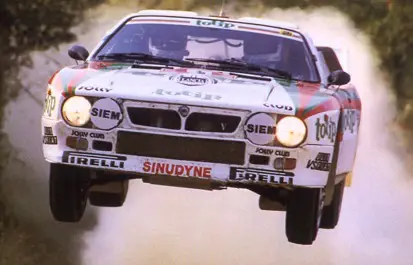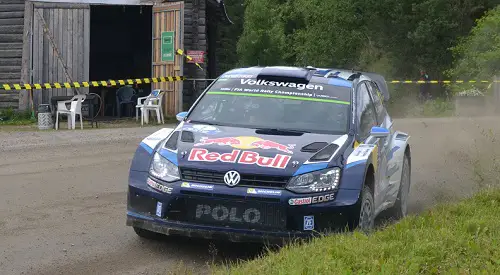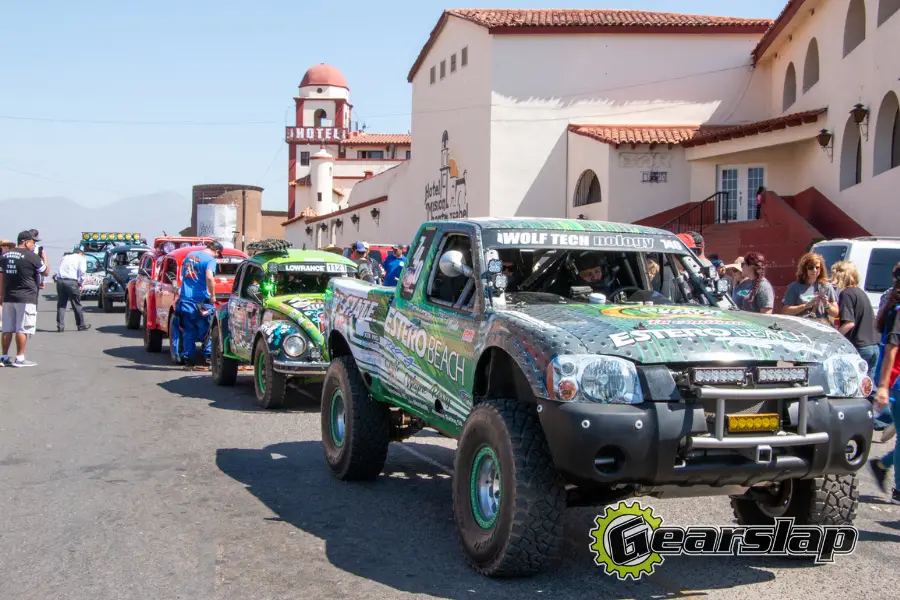Off-road racing is an exciting sport that pits cars, trucks, and motorbikes against each other in off-road conditions. What I love most is how we get to see drivers compete outside race tracks, and utilize basically all the planet has to offer to race each other.
Believe it or not, off-road racing isn’t limited to cars, trucks, and motorcycles. Drivers can even use tractors for a very interesting approach to racing. There’s a lot to learn about off-road racing, so read on and I’ll share all I know as something of an unofficial off-road expert.
What Is Off-Road Racing Called?
Off-road racing is a broad term that covers different types of motorsports. Basically, I categorize any “wheeled” motorsport that isn’t on a standard course as off-road racing. That means races on tracks, roads, or in stadiums don’t factor in.
Off-road racing most commonly refers to desert and Baja racing. However, rallying, motocross, and hill-climbing count, too. Officials hold all of these races in a natural environment. The various, and sometimes unexpected, extremes involved make it an exciting and dangerous journey.
I’m a risk-taker, so I especially love that snow and ice racing, beach racing, and mud bogging are other types of off-road motorsports. Racing on natural terrain is at the core of off-road racing. Adding in environmental elements like slippery ice, unstable sand, and sticky mud ramps up the challenge.
As I mentioned before, even tractor pulls are a type of off-road racing. Sure, drivers have to soup up the engine, but pulling a hefty weight behind a powerful tractor is a thrill like none other. In this case, the objective of the race is more about the strongest vehicle, not the maximum speed the tractor can reach.
Tractor pulls make me think about the different types of vehicles that can compete in off-road racing. Pretty much anything that’s upgraded to handle the terrain will make a great off-road vehicle. The most common vehicles we see include:
- Sport-utility vehicles (SUVs)
- All-terrain vehicles (ATVs)
- Utility-terrain vehicles (UTVs)
- Pickup trucks with four-wheel drive
- Motorcycles
The Federation of American Motorcyclists (FAM) began in 1903. Their initial goal was to champion motorcycles as vehicles appropriate for road use. With World War I on the horizon, membership died down.
By 1908, the Motorcycle and Allied Trades Association (MATA) started. They worked to regulate motorcycle manufacturing. They soon found there was no organization with the riders’ best interests in mind. The organization expanded to offer personal memberships in 1919.
Around this time, MATA awarded medals to championships. The organization grew and morphed into the American Motorcycle Association (AMA) in 1924.
After World War II, motorcycle trail racing grew incredibly popular. There were checkpoints along trails, but otherwise, the routes were largely improvised by the riders.
The sport evolved to use other vehicles. Nowadays, races are usually grouped by the type of vehicle. There are motorcycle, car, truck, or ATV races. Within that category, officials subdivide vehicles into stock or custom classes to keep rankings fair.
Most organizations hold their races in the desert because of the open spaces, and the sport is most popular in North America. In recent years, people in Japan and Australia have held off-road races, so the sport is growing in popularity around the world.
What Are the Different Types of Off-Road Racing?
The broad introduction gives a general scope of off-road racing. Hint: it’s broad. There are many different types of off-road racing and they’re all unique.
Each category of racing has set standards for the way they conduct and score racers. Drivers can compete in some types of races with a variety of vehicles, while others restrict drivers to very specific machines. There are also governing organizations for many of them, as well as famous championship races.
Desert & Baja Racing
Many people wonder, “Is desert racing off-road racing?” Based on the name alone, it sounds like they’re two separate sports. Some people even think that off-road racing is any motorsport not on an official track, and desert racing is specifically in a desert location. But off-road racing is a broad term, and desert racing falls in this scope.
Desert racing began in the 1960s. Ed Pearlman was an ex-Marine that enjoyed four-wheel driving. He co-founded the National Off-Road Racing Association (NORRA) to celebrate his hobby and host races.
NORRA held its first desert race in Baja California in 1967. Over the years the race became known as the Baja 1000. It’s now sanctioned by SCORE International, the Southern California Off-Road Enthusiasts.
It’s no surprise that organizations hold desert races on government recreational deserted land. States like Nevada and California have plenty of open deserts for these races. There are even races held in the Sahara Desert. The courses can stretch anywhere from 25 to 1,000 miles. Some races have participants loop the trail several times so drivers might cover as much as 4,000 miles.
Types of Desert Races
The previously-mentioned Baja 1000 is a point-to-point race. Drivers start in one location and end somewhere else. Another popular point-to-point race is Vegas to Reno, part of the Best In The Desert. Vehicles journey 1,000 miles from Las Vegas to Reno, staying completely off-road.
Short course off-road racing is a type of desert racing held on a closed course. The dirt road is no more than five miles long but doesn’t have to be a straight shot. The trail can include turns, jumps, and gravel pits.
Hare and Hound racing, also called the Hare Scramble, is a massive race for motorcycles and ATVs. Everyone starts at once and heads across the open desert.
A navigation rally, also called a rally raid or off-road rally, is different from rally racing. I’ll get into details about that topic next. These races require drivers to navigate the course as they’re driving.
In one of the most popular navigation rallies, Dakar, participants get the roadbook the night before each day of racing. They’re told how many kilometers they’ll drive from point to point but the rest is up to them to figure out as they go.
Vehicles for Desert Racing
Desert racing tests the endurance of the vehicle, so drivers have to choose carefully. Many trucks used for desert racing aren’t street legal. Vehicles that typically excel in desert racing include:
- Baja trucks
- Trophy trucks (in SCORE races) and trick trucks (in Best In The Desert races)
- Mini-trucks
- Truggies ( trucks and buggies combined)
- Motorcycles
- ATVs and UTVs
Top 3 Organizations in Desert Racing
SCORE International is known for the Baja 1000, Baja 500, San Felipe 250, and more. Mickey Thompson, an auto racing builder, founded the organization in 1973.
Best In The Desert (BITD) is based in Las Vegas and holds as many as 10 races each year. They’re best known for the Vegas to Reno race, which is their flagship event.
Legacy Racing is also based in Las Vegas. They sponsor five major races each year. Trucks, cars, UTVs, and motorcycles are eligible to participate.
Rallying & Rally Racing
People wonder, “Is rally racing considered off-road racing?” since it takes place on the road. Even the vehicles used are street legal. All rally races are point-to-point races, with a distinct start and finish, instead of drivers looping around a circuit.
Rallying started in 1911 with the Monte Carlo Rally in France. This race is an annual event and only paused for World Wars I and II. Since then, rallying has increased in popularity. Organizations hold many different types of this race around the world.
Types of Rally Races
Special stages are races conducted on a section of closed road or highway, usually about 30 miles long. Racers are trying to get the fastest time for that section. Drivers have staggered starts so they’re not fighting for first place, rather competing at their own speed.
When drivers race anywhere from 15 to 30 special stages, they’re competing in a stage rally. Officials determine the winner by finding the driver with the lowest overall time for all of the stages.
Drivers run road rallies on public roads. Vehicles that compete are street legal, so it’s open to a wide range of drivers. For safety reasons, these races are usually driven on rural roads or late at night so there isn’t much traffic.
Road rallies can also have special off-road courses, which is part of the reason that we categorize rally racing as off-road racing. Many cars participate in road rallies at the same time, starting about one minute apart. Drivers aren’t racing against each other, but instead, compete to get the shortest time per course.
Rallycross is a sprint type of race. The course has mixed surfaces, meaning there could be asphalt, dirt, sand, gravel, and more, all in different areas of the same track. Vehicles used in these races are usually modified and not street legal.
Vehicles for Rally Racing
Some car companies manufacture cars specifically for rallying. The British Motor Company introduced the Mini Cooper in 1962 for rally racing. Fiats and Audis are also great cars to use for rallying.
Cars with turbocharged engines and four-wheel drive will excel at rally racing. Four-wheel drive gives the drivers total control over the vehicle, even when driving on ice or gravel.
Top 3 Organizations in Rally Racing
Founded in 1904, the original goal of the Fédération Internationale de l’Automobile was to safely regulate motorsports. Over the years, it began hosting races, including its most famous: Formula One.
Though it was only founded in 2016, the American Rally Association is a major non-profit in the world of rally racing. It began hosting races in 2017 and has since earned a National Championship trophy.
Rally America held the National Championship starting in 2005, then rebranded to RallyCar in 2010. They reverted to Rally America for several years, holding their final events in 2018. They shared a major goal to launch a media organization in 2019 before shutting down their website and folding.
Motocross
Motocross got its name by combining the word motorcycle with cross country, which is a type of race run across natural terrain. Therefore, it’s only logical that motocross is off-road motorcycle racing held on courses consisting of grass, mud, or gravel. While the trail might be a closed course, the terrain remains natural. This means there are often steep hills and sharp jumps.
In England, motocross was a competitive sport as early as 1909. The sport rose to popularity in America in the 1970s. Riders used dirt bikes with 500cc or 250cc engines, though they later added a 125cc class to eligible races.
Types of Motocross Races
Most motocross races involve many drivers taking off from the starting line at the same time. They’re racing each other as well as the clock.
Recently, arenacross has become popular. Riders race dirt bikes in small indoor arenas. Though the races are inside, the course isn’t a paved road. They’re made of dirt and still have steep inclines and jumps.
Freestyle motocross (FMX) is more of an acrobatic motorsport. Instead of racing competitors, or even racing against the clock, FMX riders do stunts while jumping their bikes. They’re given scores based on the trick’s difficulty and their style of completing it. FMX first appeared in the X Games in 1999.
Supermoto courses have three sections: paved road, flat dirt, and dirt obstacles and jumps. Bikes for this competition have special treads that can safely grip both asphalt and dirt. Because the courses include paved roads, these races are sometimes held at go-kart tracks.
ATV and Quad motocross races allow four-wheelers to race on natural terrain. Some courses have ramps that are specially constructed. Others focus on the dirt paths, which turn to mud in bad weather and the race continues in these conditions.
Vehicles for Motocross
Dirt bikes are the vehicle most often used for motocross, but there are many different types of them. Other vehicles can race, including:
- Dirt bikes
- Desert motorcycles
- Enduro motorcycles
- ATVs and four-wheelers
Top 3 Organizations in Motocross
The American Motorcyclist Association boasts more than 200,000 members. They all campaign for safety in motorcycling, motorsports, and motocross. This organization hosts the famous AMA Amateur National Motocross Championship.
NESC Motocross is the New England Sports Committee based in Maine. The organization hosts races and holds classes. They even give scholarships for college students competing in motocross races.
A team of riders founded the American Freestyle Motocross Association in 2009. They created it in the honor of Jeremy Lusk, a freestyle rider who died from a crash that happened during a competition. Their goals include increasing safety in the sport, especially involving emergency medical treatment for races.
Snow & Ice Racing
Snow and ice racing takes place on lakes and rivers that have frozen over in cold weather. Some locations purposely freeze water on lots to create a course.
Because the weather needs to stay at or below freezing for ideal conditions, these races are most popular in the northern United States, Canada, and northern Europe. Some arenas hold ice racing events inside ice hockey rinks.
Vehicles for Snow & Ice Racing
Cars, trucks, and motorcycles can participate in snow and ice racing. Any vehicle that’s going to race needs special tires. Most have studs to better grip the snow or ice while driving. Since drivers can’t buy tires with studs, it’s something they must rig up themselves by attaching screws or bolts to the tire treads.
Considering the nature of studded tires and ice racing, the vehicles competing need a roll cage and other safety precautions. Studded tires grip so well that drivers can reach maximum speed, even when taking a corner, so they need to stay safe in their vehicles.
If drivers don’t want to use studded tires, they can use standard snow tires on their vehicles. While participants always need to stay safe when racing, snow tires are usually slower at taking corners, so a roll cage isn’t required.
Beach Racing
Beach racing takes place in early spring or late autumn when beaches don’t have many tourists around. A course marked on a beach can include jumps off of sand dunes. The trails have circuits that range from one to three miles each, and the riders continue to make loops for several hours.
The races primarily involve motorcycles, though some races allow passengers in sidecars.
Sand is rough on motorcycles, so riders must perform a lot of maintenance to keep their vehicles in safe riding condition.
Beach races have been popular in France since 1975. Now races are also held in Australia, the Netherlands, the United Kingdom, and the United States.
Hill Climbing
Hill-climbing is also known as speed hill-climbing and hill climb racing. From the name alone, it’s easy to tell that the course is mostly uphill. Drivers race against the clock rather than each other.
Because some of the hills are so steep, speed alone doesn’t determine the winner. Some vehicles aren’t able to make it to the top of the course, so they’re not eligible to win.
Motorcycles are most often used in hill climbing races, but drivers can soup up both open and closed cockpit cars to make the trek. Rock crawlers are special vehicles made for off-road driving. They can handle harsh terrain, so hill climbing is no problem in these machines.
The first recorded hill-climbing race was in France in 1897. It then expanded to England in the early 1900s before spreading through Europe and to North America in the 1950s. The most famous races include:
- Pikes Peak in Colorado
- Harewood in the United Kingdom
- Gurnigelrennen in Switzerland.
Tractor Pulls
As previously mentioned, tractor pulls are a unique type of off-road racing. It’s one motorsport where speed doesn’t matter. Instead, the winner is the strongest tractor on the course. The track itself is only about 30 feet wide, but it’s at least 300 feet long. This length is to see which tractor can haul the sled weight the farthest distance.
Competitors modify their tractors with souped-up tires and engines. Still, the weight they must pull leeches the horsepower. Very few tractors reach the finish line on the course, so the winner is who makes it the farthest before losing power. Officials measure the distance down to thousandths of an inch.
Mud Bogging & Swamp Buggies
Mud bogging is off-road racing with a “course” that’s a mud pit. As with tractor pulls, speed isn’t the goal here. Instead, participants want to be the vehicle that makes it farthest across the pit. Their effort is also timed, just in case several vehicles make it all the way across.
Vehicles that compete in mud bogging need to have four-wheel drive. Other than that, different classes of vehicles race in various categories. The Mud Racers Association classifies vehicles, sponsors races, and keeps the sport safe.
Land Speed Records
The land speed record refers to the highest speed achieved by a driver and vehicle on land. Officials calculate the record itself by averaging two passes on the same course. It’s officiated by the Fédération Internationale de l’Automobile.
Wheel-driven land speed records go back as far as 1898. The Outright Land Speed Record is 763 miles per hour, but there are many different categories. Other records depend on engine type, vehicle weight, and more. In addition to wheel-driven vehicle records, there are steam and rocket-propelled records.
Records are also determined by the type, of course, they’re run on. The driver who holds the current world record raced in the Black Rock Desert. Other racers compete at test centers and raceway parks. Some records were even set on courses through abandoned airfields, dry lake beds, and salt flats.
Noteworthy records include the fastest land speed on a public road and the first driver to break the speed of sound. Some drivers who set land speed records were knighted for their accomplishments.
It’s also interesting to note the landmark records. Examples include the first time a wheel-driven vehicle beat a train, the first record over 100 miles per hour, and the last wheel-driven record before manufacturers introduced turbojet engines.






